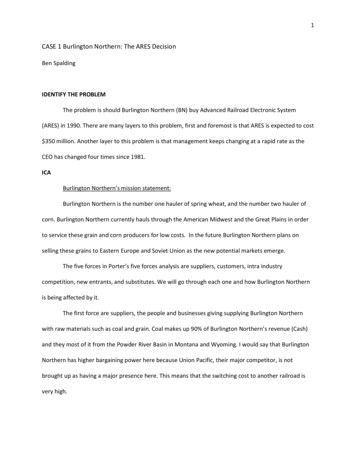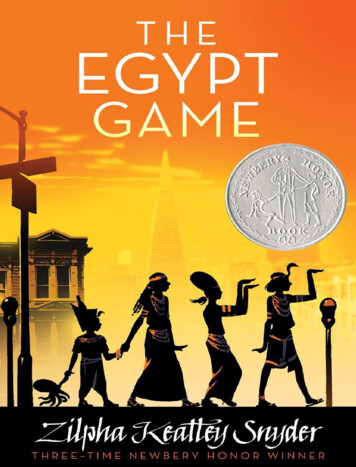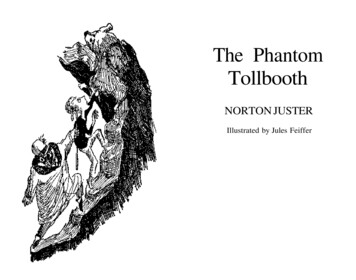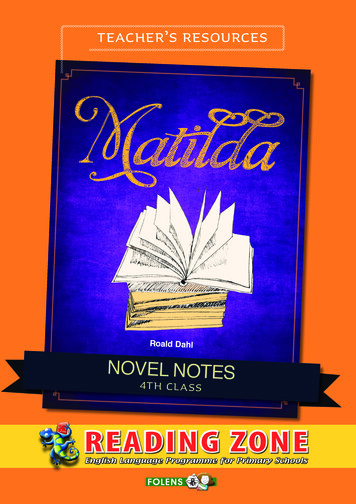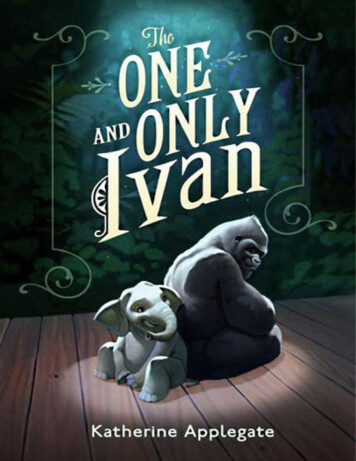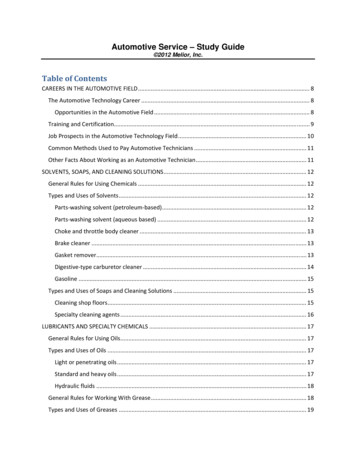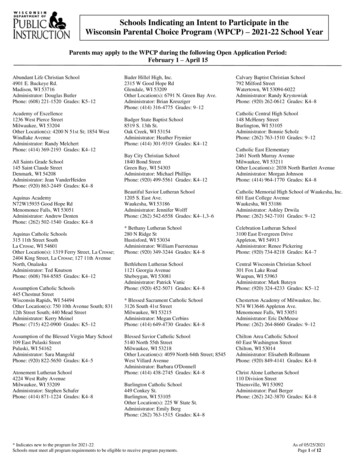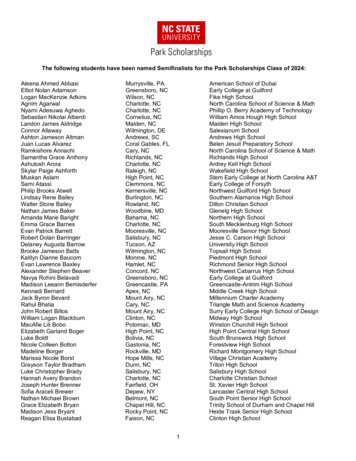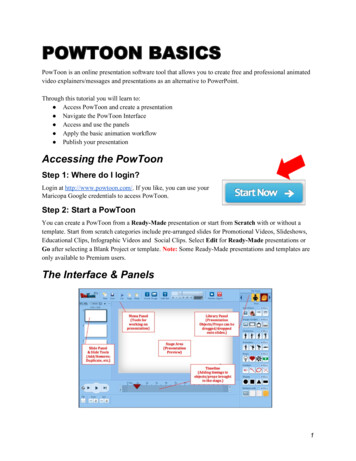
Transcription
POWTOON BASICSPowToon is an online presentation software tool that allows you to create free and professional animatedvideo explainers/messages and presentations as an alternative to PowerPoint.Through this tutorial you will learn to: Access PowToon and create a presentation Navigate the PowToon Interface Access and use the panels Apply the basic animation workflow Publish your presentationAccessing the PowToonStep 1: Where do I login?Login at http://www.powtoon.com/ . If you like, you can use yourMaricopa Google credentials to access PowToon.Step 2: Start a PowToonYou can create a PowToon from a Ready Made p resentation or start from Scratch with or without atemplate. Start from scratch categories include pre arranged slides for Promotional Videos, Slideshows,Educational Clips, Infographic Videos and Social Clips. Select Edit for Ready Made presentations orGo after selecting a Blank Project or template. Note: Some Ready Made presentations and templates areonly available to Premium users.The Interface & Panels1
The Library PanelThe PowToon Library is made up of different categories of text,objects (shapes, markers), props and characters that can be added toyour presentation. You can even add your own images to thelibrary by selecting an Image Holder (image frame) option.Using Items in the LibraryTo use the Library select a Style from the top of the panel. To addobjects, props and characters simply drag/drop to the slide. Note:Some Items in the Library may be part of the premium PowToonpackage (marked as “ More” ).The TimelineThe PowToon Timeline is used to add animation timing to objectsin your presentation.1. Playhead: The playhead indicates at what second you arecurrently in your slide. You can slide the playheadthroughout the timeline to preview the animation for each slide.2. Total Slide Time: Each slide by default is assigned 10 seconds. This can be decreased orincreased to up to 20 seconds maximum.3. Object Duration Bar: Each object has a animation timing duration bar. To access this bar selectthe object on the stage and adjust the timing as desired.4. Object Thumbnails: All objects in the slide will appear below the timeline. Click on an object toadjust the effect and duration of the object.5. Object Effects (Animation): Objects can be set to Enter or Exit the stage using a variety ofoptions including fades, directionality and even a hand function (where a human hand slides theobject onto the presentation). Each object can be animated using these effects. Note: You can alsoFlip an object’s orientation from this area.6. Playback Controls: Help you preview your presentation animation as you go. Note: there are four playback options f rom left to right (a) play all slides from start, (b) play current slidefrom start, (c) play from playhead then continue, and (d) play current slide.2
The Slide PanelThe Slide Panel contains your slides for yourpresentation.Slide Options: You can add/remove andduplicate slides (all objects and timing). Note:You can also clone slides, which duplicates theprevious slide with the last frame (1 second) onit. This can help you make a smooth transitionfrom slide to slide.Presentation/Movie Mode: T oggle betweenthe movie and presentation modes dependingon how you want to show or explain yourinformation. Note: Presentation mode allowsyou to create Hold Points for live presentationnarration.Transitions: Transitions between slides can be added byaccessing the Transition Options from the Library Panel . Toadd a transition, select the slide and click on the desiredtransition effect. The transition will appear below the selectedslide and the name of the transition effect will appear betweenthe two slides. Note: Transitions are a standard length andcannot be edited. To remove a transition, select the slide andfrom Transition options from the Library Panel , select None .Layouts: Layouts for slides includeanimation placeholders and basictimings. Access the slide layout optionsby clicking on the slide and selectingthe layout options tab. A menu oflayouts will appear. Select a layout.Edit the individual items on the slide and timings to adjust the effects. Note: You can only apply a layoutoption to a slide once. To apply a new layout, simply add a new slide and select a new layout option.The Menu PanelThe Menu Panel contains features common to many presentation tools.3
Save: although PowToon will autosave every 5 minutes; it is important to save regularly.New: to create a new PowToon.Cut, Copy, Paste: cut, copy and paste slides, objects in your presentation.Sound: add a sound file (either import, record or use a track from the PowToon).Image: Import image from computer or from the web.Text: add text to a slide and format text options.Preview (Share/Link, Embed): Select preview to review your PowToon and share via a URLlink, social media site or embed into a web site.8. Exporting (YouTube): directly share your PowToon to YouTube or export as a video file (paidoption). Note: free accounts include PowToon branding.1.2.3.4.5.6.7.The Basic WorkFlowStep 1: StoryboardIt is highly recommended that you plan your presentationusing a storyboard that outlines your visual ideas andnarration. It is the most effective approach for animation.Step 2: Add the Voiceover/MusicIt is much easier to add the voiceover first then add theanimations. Why? It provides you with the timings,making it easier to add slides and animations.Adding SoundFrom the Menu Panel select Sound OR select the Audio Icon from the Timeline.1. Import or Record Voiceover2. Import or Add Music Track Note: Some music requires a paid account.3. Adjust sound with controls4. Preview / Play5. Apply4
Step 3: Add SlidesUsing the Slide Panel add slides to your presentation based on your storyboard.Step 4: Add ObjectsDrag and drop objects from the PowToon Library Panel ontoyour slides (including characters, text, objects and props).Tip: You can layer objects on top of each other and use theanimation timings to introduce objects strategically to create asense of dynamic movement and cartoon interaction.Managing ObjectsManaging objects in PowToon is similar to MSPowerPoint. Left click on the item to select and eitherhold and move on the stage with the mouseor use the arrow keys. Use the object handles to resize the object. Right click for more object managementoptions such as arrangement (back, front),orientation (flip), etc.Step 5: AnimateObjectsFrom the Timeline use theDuration Bar to animate eachobject on the slide.1. Select the object toanimate.2. Choose an effect stylefor the objectentry/exit.3. Use the sliders toadjust the duration ofthe object animation in the slide.4. Add/Remove overall slide timing as needed (slides can be up to 20 seconds in length).Step 4: PreviewUse the Playback Controls OR select Preview from the Menu Panel to review your video. NOTE:Don’t forget to save throughout the process of creating your presentation. The save feature is located inthe Menu Panel .5
Step 5: PublishTo Publish your PowToon select from thefollowing:Share Via Link or Embed1. Select Preview from the MenuPanel2. Choose from one of the sharingoptions in the Preview dialog.Export to YouTube/Other1. Select Export from the Menu Panel2. In the dialog select an output option and Add a YouTube Account. NOTE: In the FREEPowToon account you can only export up to 30 videos at medium resolution with branding.Video exports are also part of premium packages.Additional ResourcesVideo Book & /www.powtoon.com/blog/EditorialsAnimated Videos: http://www.powtoon.com/blog/russ explains/Video Marketing: http://www.powtoon.com/blog/just a minute explainers/Video Presentations: https://tinyurl.com/POWTOONPres6
Step 1: Storyboard It is highly recommended that you plan your presentation using a storyboard that outlines your visual ideas and narration. It is the most effective approach for animation. Step
